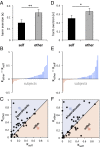Harm to others outweighs harm to self in moral decision making
- PMID: 25404350
- PMCID: PMC4260587
- DOI: 10.1073/pnas.1408988111
Harm to others outweighs harm to self in moral decision making
Erratum in
-
Correction for Crockett et al., Harm to others outweighs harm to self in moral decision making.Proc Natl Acad Sci U S A. 2015 Jan 27;112(4):E381. doi: 10.1073/pnas.1424572112. Epub 2015 Jan 8. Proc Natl Acad Sci U S A. 2015. PMID: 25572965 Free PMC article. No abstract available.
Abstract
Concern for the suffering of others is central to moral decision making. How humans evaluate others' suffering, relative to their own suffering, is unknown. We investigated this question by inviting subjects to trade off profits for themselves against pain experienced either by themselves or an anonymous other person. Subjects made choices between different amounts of money and different numbers of painful electric shocks. We independently varied the recipient of the shocks (self vs. other) and whether the choice involved paying to decrease pain or profiting by increasing pain. We built computational models to quantify the relative values subjects ascribed to pain for themselves and others in this setting. In two studies we show that most people valued others' pain more than their own pain. This was evident in a willingness to pay more to reduce others' pain than their own and a requirement for more compensation to increase others' pain relative to their own. This "hyperaltruistic" valuation of others' pain was linked to slower responding when making decisions that affected others, consistent with an engagement of deliberative processes in moral decision making. Subclinical psychopathic traits correlated negatively with aversion to pain for both self and others, in line with reports of aversive processing deficits in psychopathy. Our results provide evidence for a circumstance in which people care more for others than themselves. Determining the precise boundaries of this surprisingly prosocial disposition has implications for understanding human moral decision making and its disturbance in antisocial behavior.
Keywords: altruism; decision making; morality; social preferences; valuation.
Conflict of interest statement
The authors declare no conflict of interest.
Figures



References
-
- Blair RJR. A cognitive developmental approach to mortality: Investigating the psychopath. Cognition. 1995;57(1):1–29. - PubMed
-
- Anderson DA. The cost of crime. Found TrendsR Microecon. 2012;7(3):209–265.
-
- Engel C. Dictator games: A meta study. Exp Econ. 2011;14(4):583–610.
-
- Rand DG, Greene JD, Nowak MA. Spontaneous giving and calculated greed. Nature. 2012;489(7416):427–430. - PubMed
-
- Henrich J, et al. Markets, religion, community size, and the evolution of fairness and punishment. Science. 2010;327(5972):1480–1484. - PubMed
Publication types
MeSH terms
Grants and funding
LinkOut - more resources
Full Text Sources
Other Literature Sources
Medical

